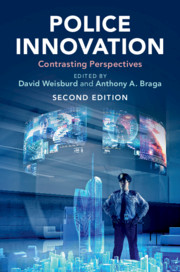Book contents
- Police Innovation
- Police Innovation
- Copyright page
- Contents
- Figures
- Tables
- Notes on Contributors
- Introduction
- Part I Community Policing
- Part II Procedural Justice Policing
- Part III Broken Windows Policing
- Part IV Problem–Oriented Policing
- Part V Pulling Levers (Focused Deterrence) Policing
- Part VI Third–Party Policing
- Part VII Hot Spots Policing
- Part VIII Predictive Policing
- Part IX CompStat
- Part X Evidence-Based/ Risk-Focused Policing
- Part XI Technology Policing
- Index
- References
Part III - Broken Windows Policing
Published online by Cambridge University Press: 09 August 2019
- Police Innovation
- Police Innovation
- Copyright page
- Contents
- Figures
- Tables
- Notes on Contributors
- Introduction
- Part I Community Policing
- Part II Procedural Justice Policing
- Part III Broken Windows Policing
- Part IV Problem–Oriented Policing
- Part V Pulling Levers (Focused Deterrence) Policing
- Part VI Third–Party Policing
- Part VII Hot Spots Policing
- Part VIII Predictive Policing
- Part IX CompStat
- Part X Evidence-Based/ Risk-Focused Policing
- Part XI Technology Policing
- Index
- References
Summary
Despite attacks from the criminological, legal, and academic left, “broken windows” theory is a robust policy option in criminal justice practice and crime prevention. It has not only fueled the community policing movement, it has also informed the evolution of community courts, community prosecution, and community probation and parole. The Mid-town Manhattan Community Court, to give just one example, emphasizes broken windows’ ideas in its philosophy and practice. Moreover, the ideas embodied in broken windows have moved beyond criminal justice and criminology to areas like public health, education, parks, and business improvement districts (BIDs).
- Type
- Chapter
- Information
- Police InnovationContrasting Perspectives, pp. 119 - 162Publisher: Cambridge University PressPrint publication year: 2019

